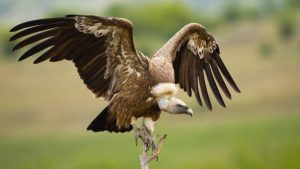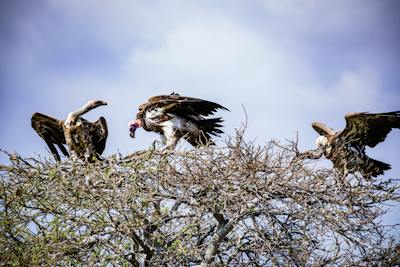What poses the most threat to vultures, is one of the questions on animal lovers mind.
Vultures are birds predominant in Africa, Europe, with known populations and distribution range becoming dramatically smaller over the 20th Century, in places like Europe due to human-induced threats.
But, with this dwindling came awareness, this awareness brought about immediate and extensive conservation actions which have been effective in the boost of vulture numbers in Europe.
But, to really tackle and conserve this specie, one needs to identify what poses a threat to vultures.
With what research have proven, there are a lot of threats to these bird. Some of which include poisoning, electrocution etc.
Let’s delve a bit deeper into analyzing these threats.
Some Threat to Vultures

Poisoning
Poisoning stands out as the most significant threat to vultures today. Poisoning here are in most cases targeted at terrestrial predators such as foxes to protect livestock and game animals.
But, somehow vultures ingest poison baits, apparently because they eat dead meat (carcasses) etc.
“Poisoning” may also arise as unintentional.
Though in a study major threats to vulture populations were seen being constituted by four quantitative factors in 26 countries.
They include:
“Trade in traditional medicine” this is identified with the number of vultures found dead with their heads off or their parts counted on sale in markets.
Others included: Killing for food, and electroshock,
Vet Drugs
The next statistically proven threat to vultures is vet drugs. This is also a type of poisoning but unintentional.
It happens when vultures feed on the remains of livestock that were treated with certain veterinary products e.g the Non-Steroidal Anti Inflammatory Drug (NSAID) diclofenac.
This drug is linked with causing in less than a decade, about 95% estimated decline of three Gyps species in India.
It got banned, but somehow have been found in recent years to have entered the EU, and organizations campaigned widely to ban Diclofenac to protect vultures.
However, the ban somehow metamorphosed to recommended strategies of several risk management measures by the European Medicines Agency.
With this came adjustments like – more regulation, veterinary controls and better labelling.
Electrocution
This is another way vultures die in their numbers, like most birds, they fly and land.
Unfortunately, sometimes on dangerous pylons, vultures often touch wires that carry high voltage and die from the accompanying electric shock, which does add to declines in their populations.
With the burden to conserve beds, electric companies are more deliberate in insulating high-risk electricity lines or install more modernized designs to reduce and sometimes eliminate the risk of bird electrocutions.
These have proven to be less dangerous and of course more effective.
Pole designs often are buried in underground lines or high-biodiversity areas as an alternative to manage risks.
Food Shortage
Vultures are facing food availability reduction in recent years as a result of decline in extensive farming and the introduction of strict carcass disposal legislation enacted by some countries.
As a medium to walk around this threat, some places have made projects and obtained a derogation from the EU regulations regarding the disposal of so-called Animal by-products (ABPs), that is aimed at enabling farmers to dispose carcasses at feeding sites, and so provide not just food but safe food to vultures.
Collision
Collisions occur when vultures do not distinguish power lines or wind turbines against the background.
The risks of collision is curbed when high visibility reflectors and spirals are added to cables to help improve the visibility of power lines which reduces the risk of collision.
Conclusion
It maybe impossible to adequately stop all threat to vultures. But, when humans are aware and are more inclined towards conversation.
They will be a high reduction of risk factors that may claim these bird’s life.
